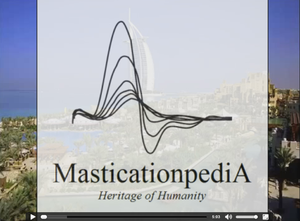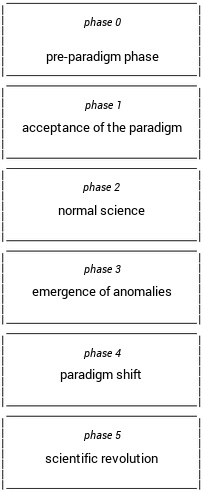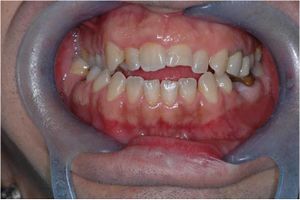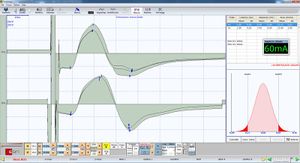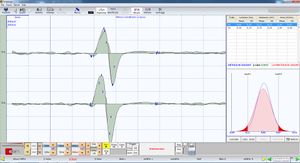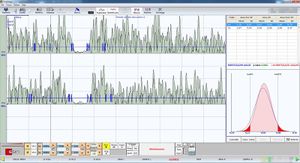Einführung
Wir möchten, dass unser Leser die Themen, die in Masticationpedia diskutiert werden, sofort wahrnimmt. Wir werden einige der aktuellsten Fragen zur erkenntnistheoretischen Entwicklung der Wissenschaft im Allgemeinen und der medizinischen und zahnmedizinischen Medizin im Besonderen behandeln.
Sie können sich auch ein video of ours auf Youtube ansehen.
Einführung
In dieser Phase werden wir zwei grundlegende Aspekte des Fortschritts der Wissenschaft gemäß den Kuhn-Paradigmen und der Erkenntnistheorie betrachten, die die Konzepte der "statistischen Inferenz" und "statistische Inferenz" in Frage stellen "Interdisziplinarität".
Diese beiden Themen, die anscheinend in Konflikt miteinander zu stehen scheinen, da das erste "Disziplinarität" benötigt, um die "Anomalien im Paradigma" hervorzuheben, und das zweite "Interdisziplinarität" benötigt, werden sie durch integrieren ein auflösendes Element, das aus "metakognitiven Gerüsten" besteht, dh kognitiven Brücken zwischen Fachdisziplinen. In diesem Zusammenhang wird der Leser daher besser in der Lage sein, die stochastische Herangehensweise an eines der umstrittensten Themen bei Kaurehabilitationen wie Malokklusion zu verstehen, von denen die meisten stammen die Kau-Rehabilitationsverfahren wie Kieferorthopädie, Prothese und orthognathische Chirurgie.
Neben der Vorwegnahme des wissenschaftlichen und philosophischen Aspekts von Masticationpedia werden wir uns schließlich auf Themen wie "Komplexe Systeme", das "Emergent Behaviour" komplexer Systeme und "System's Coherence" konzentrieren: notwendige Schritte zur Einführung wissenschaftlicher klinischer Themen, die dies mit sich bringen mit ihnen Zweifel, Fragen und gleichzeitig paradigmatische Innovationen, die dazu neigen, den Status quo der deterministischen und reduktionistischen klinischen Denkroutine vor einer stochastischen und interdisziplinären Sprachlogik zu verändern.
Article by Gianni Frisardi
|
Ab ovo[1]
Bevor wir zum Kern der Masticationpedia-Behandlung kommen, ist eine Prämisse angebracht, die hauptsächlich zwei Aspekte der sozialen, wissenschaftlichen und klinischen Realität der gegenwärtigen und der unmittelbar vorangegangenen Ära betrifft.
Im letzten Jahrhundert haben wir ein exponentielles Wachstum technologischer und methodischer "Innovationen" speziell in der Zahnheilkunde erlebt[2]; Diese Innovationen haben in gewisser Weise Entscheidungsstrategien, Meinungen, Denkschulen und Axiome beeinflusst, um die Lebensqualität zu verbessern, wie es in der "Exposure Science in the 21st Century" heißt.[3]. Dieses exponentielle Wachstum bringt jedoch implizit konzeptionelle Grauzonen (in der Praxis "Nebenwirkungen") mit sich, die manchmal unterschätzt werden, aber einige wissenschaftliche Gewissheiten in Frage stellen oder weniger absolut und wahrscheinlicher machen können.[4]
Die beiden sensiblen Aspekte der gegenwärtigen gesellschaftlichen, wissenschaftlichen und klinischen Realität (die miteinander zu kollidieren scheinen, sich aber, wie wir am Ende dieser Lektüre sehen werden, ergänzen werden) sind der "Fortschritt der Wissenschaft" nach Kuhn und die " Erkenntnistheorie".
Wissenschaftsfortschritt nach Thomas Kuhn
Thomas Kuhn in seinem berühmtesten Werk heißt es, dass Wissenschaft zyklisch einige Phasen durchläuft, die auf ihren Betrieb hinweisen.[5][6] Laut Kuhn ist „Wissenschaft paradigmatisch“ und die Abgrenzung zwischen Wissenschaft und Pseudowissenschaft lässt sich auf die Existenz eines „Paradigmas“ zurückführen. Die Entwicklung des wissenschaftlichen Fortschritts wird einer kontinuierlichen Kurve, die bei Paradigmenwechseln Diskontinuität unterliegt gleichgesetzt. In Phase 2 der Kuhn-Paradigmen, genannt Normal Science', werden Wissenschaftler beispielsweise als Problemlöser angesehen, die daran arbeiten, die Übereinstimmung zwischen Paradigma und Natur zu verbessern.
Tatsächlich basiert diese Phase auf einer Reihe von Grundprinzipien, die vom Paradigma diktiert werden, die nicht in Frage gestellt werden, sondern denen die Aufgabe anvertraut ist, die Koordinaten der kommenden Werke anzugeben. In dieser Phase werden die Messgeräte, mit denen die Experimente durchgeführt werden, entwickelt, die meisten wissenschaftlichen Artikel erstellt und deren Ergebnisse einen erheblichen Zuwachs an wissenschaftlichen Erkenntnissen darstellen. In der normalen Wissenschaftsphase werden sowohl Erfolge als auch Misserfolge erzielt; die Ausfälle nennt Kuhn Anomalien, oder Ereignisse, die gegen das Paradigma verstoßen.
Als guter Problemlöser versucht der Wissenschaftler, diese Anomalien zu lösen.
Kuhn teilt jedoch die Evolution eines Paradigmas in „fünf Phasen“ ein; Dies ist ein grundlegender Prozess für Masticationpedia, aber um mit dem Projekt Schritt zu halten, beschränken wir uns auf die Beschreibung der beiden wichtigsten Phasen:
| |
|
Es ist fast offensichtlich, dass die Kuhnsche wissenschaftliche Philosophie Disziplinarität bevorzugt, da eine Anomalie im genomischen Paradigma von einem Genetiker besser bemerkt wird als von einem Neurophysiologen. Nun scheint dieses Konzept im Gegensatz zur epistemologischen Entwicklung der Wissenschaft zu stehen, daher ist es besser, eine Minute im Detail darauf zu verweilen.
Erkenntnistheorie
| Der schwarze Schwan symbolisiert eines der historischen Probleme der Erkenntnistheorie: Wenn alle Schwäne, die wir bisher gesehen haben, weiß sind, können wir dann entscheiden, dass alle Schwäne weiß sind? "Ja wirklich?" |
|
| Kuhn demonstrierte mit der optischen Täuschung, wie ein Paradigmenwechsel dazu führen kann, dass ein Mensch die gleichen Informationen ganz anders sieht: Welches Tier ist hier das andere? Sicher? |
Epistemology (aus dem Griechischen ἐπιστήμ', epistème, „gewisses Wissen“ oder „Wissenschaft“, und λόγος,logos, „Rede“) ist jener Zweig der Philosophie, der sich mit der Bedingungen, unter denen wissenschaftliche Erkenntnisse erlangt werden können, und die Methoden, um solche Erkenntnisse zu erlangen.[7] Der Begriff bezeichnet speziell den Teil der Gnoseologie, der die Grundlagen, Gültigkeit und Grenzen wissenschaftlicher Erkenntnisse untersucht. Im englischsprachigen Raum wird der Begriff der Erkenntnistheorie stattdessen hauptsächlich als Synonym für Gnoseologie oder Wissenstheorie verwendet – die Disziplin, die sich mit der Erforschung des Wissens beschäftigt.
Das Grundproblem der Erkenntnistheorie bleibt übrigens heute wie zu Humes Zeit das der Überprüfbarkeit.[8][9]
Das Hempel-Paradox sagt uns, dass jeder gesichtete weiße Schwan bestätigt, dass Krähen schwarz sind[10]; das heißt, jedes Beispiel, das nicht im Gegensatz zur Theorie steht, bestätigt einen Teil davon :
Dem Einwand der Falsifizierbarkeit zufolge ist dagegen keine Theorie jemals wahr, denn es gibt zwar nur endlich viele Experimente dafür, aber theoretisch auch unendlich viele, die sie falsifizieren könnten.[11]
|
Aber es ist nicht alles so offensichtlich ... |
... weil das Konzept der Erkenntnistheorie auf kontinuierliche Implementierungen wie in der Medizin trifft:
|
|
Anomaly vs. Interdisciplinarity
Given the above, on a superficial view of the epistemic evolution of the Science, the two aspects of disciplinarity ("Physics Paradigm of Science", highlighting the anomaly) and Interdisciplinary ("Engineering Paradigm of Science", metacognitive scaffold), might seem to be in conflict with each other; in reality, however, as we are just going to see right in this chapter, they are two sides of the same coin because both tend to generate "Paradigmatic Innovation" without any conflict at all.
Now we could conclude that the "Innovations" are already "Progress of Science" in themselves, as stated in the article "Scientific basis of dentistry" by Yegane Guven, in which the effect of biological and digital revolutions is considered on dental education and daily clinical practice, such as personalized regenerative dentistry, nanotechnologies, virtual reality simulations, genomic information and stem cell studies.[21] The innovations mentioned by Guven are obviously to be considered as technological and methodological in nature; however, the Progress of Science does not move forward with this kind of Innovations, which are called "Incremental Innovations" and "Radical Innovations", but it occurs substantially through "Paradigmatic Innovations".
In the strictest sense of the phrase, "Paradigmatic Innovations" are essentially a change of thought and awareness that pervades the whole of humanity, starting from different social strata, from the Copernican scientific revolution to the current trend of Stochastic approach to the biological phenomenon[22].
In this epistemological context (in addition to other initiatives such as the Research Diagnostic Criteria in the field of the Temporomandibular Disorders — RDC/TMDs), of the Evidence Based Medicine (and other), the Masticationpedia project inserts itself in order to highlight the dialectics dynamism about the progress of the masticatory rehabilitation science. Masticationpedia tends, moreover, to highlight the anomalies that inevitably stimulate a change of thought and therefore a "Paradigmatic Innovation".
Before proceeeding, it could be appropriate to observe a very concrete and significant case.
Malocclusion
Malocclusion: it literally means a bad (malum, in Latin) closure of the dentition[23]. The closure is easy to understand, we believe, but the epithet "bad" must be understood with care as well, because it is not as simple as it seems.
To briefly grasp the concept, in this first introductory reading we will try to present a simple but highly debatable question that involves a series of other questions in the field of masticatory rehabilitation and especially in orthodontic disciplines: what is "Malocclusion"? Bear in mind that in 2019, a Pubmed query about this term returned a result of "only" 33,309 articles[24], which says it all about the hypothetical terminological agreement on the subject; and, therefore, very meaningful conclusions could be drawn every now and then from these articles, such as the ones we reproduce in full from an article by Smaglyuk and collaborators, a somewhat "sensational" article that deals with the interdisciplinary approach in the diagnosis of malocclusions[25]:
Another noteworthy fact is that if in the same 2019 Pubmed was questioned on interdisciplinarity in the diagnosis of malocclusions, the result dropped drastically to just four articles[26].
These premises to the "Malocclusion” question indicate, on one hand, an alert about anomalies that tend to activate Kuhn phase 4 and, on the other, a bifurcation in the epistemic choice on the subject: one that generates Incremental Innovations (others 33,309 articles, perhaps) and another that prefers a new gnoseological path of "Paradigmatic Innovation”.
Let’s try to approach part of the concept that considers the "Paradigmatic Innovation” as essential, asking ourselves for example:
|
What does "Malocclusion" mean? |
We will answer this question by reporting a clinical case of evident “Malocclusion”.
Patient is with an occlusion that orthodontists call “Malocclusion” because it has a posterior unilateral crossbite and anterior openbite[27]; it is a malocclusion that can be treated with a fixed orthodontic therapy and possibly in combination with an orthognathic intervention[28]. Crossbite is another element of disturbance in normal occlusion because of which it is obligatorily treated together with the openbite[29][30][31].
It is self-evident that an observer with a deterministic mindset facing a phenomenon of such evident occlusal incongruity considers crossbite and openbite the cause of malocclusion (cause/effect) or vice versa; and it is obvious, as well, that the observer recommends an orthodontic treatment to restore a “Normocclusion”. This way of reasoning means that the model (masticatory system) is “normalized to occlusion”; and if read backwards, it means that the occlusal discrepancy is the cause of malocclusion and, therefore, of disease of the Masticatory System. (Figure 1a).
But let's hear what the two players say, the dentist and the patient, in the informative dialogue.
| The dentist tells the patient that he is suffering from severe malocclusion and that it should be treated to improve its aesthetics and chewing function. The patient, however, replies firmly: «No way, I haven't the slightest idea to do it at all, doctor, because I might even have an unrepresentative smile, but I eat very well.» The dentist’s reply is ready, so the practitioner insists by saying: «but you have a serious malocclusion with an openbite and a unilateral posterior crossbite, you should already have problems with bruxism and swallowing, as well as posture.» The patient closes the confrontation in a decisive way: «absolutely false: I chew very well, I swallow very well and at night I snore alot so I don’t grind; besides, I’m a sportsman and I don’t have any postural disturbance». |
Now the conclusion remains very critical because we might be finding ourselves in front of a verbal language of the patient which is misleading because it is not specific and does not respond to a detailed physiopathogenetic knowledge of the occlusal state; or, paradoxically, we are otherwise facing a machine language converted into verbal language which guarantees the integrity of the system. At this point the situation is truly embarrassing because neither the patient nor the observer (dentist) will be able to say with certainty that the System is in a “Malocclusion” state.
It is precisely at this moment that one remembers the criticism of the American Statistician Association titled “Statistical inference in the 21st century: A World Beyond p <0.05”, which urges the researcher to accept uncertainty, be sensible reflective, open and modest in his statements[16]: which basically translates into a search for interdisciplinarity.
Interdisciplinarity, in fact, could answer such a complex question; but it is nonetheless necessary to interpret the biological phenomenon of "“Malocclusion”" with a stochastic forma mentis of which we will discuss in detail later.
A stochastic observer may observe that there is a low probability that the patient, at the moment , is in a state of occlusal disease, as the patient's natural language indicates ideal psychophysical health; he/she then concludes that the occlusal discrepancy could not be a cause of neuromuscular and psychophysical functional disorder. In this case, therefore, the Masticatory System can not only be normalized to the occlusion only, but a more complex model is needed too, so it has to be normalized to the Trigeminal Nervous System. The patient was then served a series of trigeminal electrophysiological tests to assess the integrity of his/her Trigeminal Nervous System in these “"Malocclusion”" clinical conditions.
We can see the following output responses, which we report directly in figures 1b, 1c and 1d (with explanation in the caption, to simplify the discussion). These tests and their description by now should only be considered as “Conceptual Rationale” for the “Malocclusion” question; later they will be widely described and their analysis detailed in the specific chapters. It can already be noted in this first descriptive approach to the masticatory phenomenon that there is an evident discrepancy between the occlusal state (which at first would support the orthodoxy of classical orthodontics in considering it as “Malocclusive State”) and the neurophysiological data indicating incredible synchronization and perfect symmetry of the trigeminal reflexes.
These results can be attributed to anything less than a "malocclusion": we are obviously in front of an error of the logic Language in medicine, in this case it is in fact more appropriate to talk about...
|
Occlusal dysmorphism and not Malocclusion (which, as we shall see a little further on, is quite another thing) |
Conclusion
Even before drawing conclusions, conceptual clarity must be made on some fundamental points which of course will be treated in detail in the specific chapters of Masticationpedia.
The Masticatory System should be considered as a “Complex System”[32], not as a Biomechanical System focused exclusively on dental occlusion, because in this sense the “Occlusion” is nothing more than a subset of the Complex System interacting with the other subsets, such as periodontal receptors, neuromuscular spindles, recruitment of motor units, central nervous system, temporomandibular joint, etc., to give shape to an “Emerging Behaviour”, the masticatory one.
The peculiarity of this concept is that it is not possible to interpret or predict the “Emerging Behaviour” of a System by extracting objective data from a single subset. Instead, the integrity of the System must be quantified in its entirety, and only then can a segmentation of the whole be attempted to make an analytical description of the node itself. There are very important intellectual and scientific movements that are engaging with this issue; in this regard, the extraordinary work of Prof. Kazem Sadegh-Zadeh: Handbook of Analytic Philosophy of Medicine comes to mind.[33]
In the presented case, the question is resolved in the following language logic:
- The subsets of the Masticatory System (teeth, occlusion, Temporomandibular joints, muscles, etc.) are in a state of "Coherence” with the Central Trigeminal Nervous System (see figures 1b, 1c and 1d), so the term “Malocclusion” cannot be used, the phrase “Occlusal Dismorphism” should be considered instead.
- «This does not mean abolishing prosthetic, orthodontic and orthognathic masticatory rehabilitation treatments: on the contrary, this forma mentis tends to restore medical knowledge to dental rehabilitation disciplines, as well as offering an alternative to the scientific reductionism that converges in a deterministic interpretation of the biological phenomenon.»
Going beyond the specialist perimeters of the disciplines, as previously reported on interdisciplinarity, helps expanding the diagnostic and therapeutic models as it can be seen in the clinical Case in which a patient was treated with the OrthoNeuroGnathodontic method is reported.
In this way, an overall view of the entire Masticatory System is presented in order to gather the aesthetic and functional-neurophysiological components together to determine “Occlusal Stability” and to avoid “Relapses”, especially in orthodontic and orthognathic treatments.[34][35]
These are just some of the topics that will be covered extensively both in this chapter and in what we call “Extraordinary Science”. Meanwhile, in a fitting diversion our colourful friend Linus Sapiens, the little yellow man on the left, asks us:
- ↑ Latein für "von Anfang an"
- ↑ Heft MW, Fox CH, Duncan RP, «Assessing the Translation of Research and Innovation into Dental Practice», in JDR Clin Trans Res, 2019.
DOI:10.1177/2380084419879391 - ↑ «Exposure Science in the 21st Century. A Vision and a Strategy», Committee on Human and Environmental Exposure Science in the 21st Century; Board on Environmental Studies and Toxicology; Division on Earth and Life Studies; National Research Council..
ISBN: 0-309-26468-5 - ↑ Liu L, Li Y, «The unexpected side effects and safety of therapeutic monoclonal antibodies», in Drugs Today, 2014, Barcellona.
DOI:10.1358/dot.2014.50.1.2076506 - ↑ Thomas Samuel Kuhn (Cincinnati, 18 july 1922 – Cambridge, 17 june 1996) war ein amerikanischer Wissenschaftsphilosoph.
Wenn es Treccani, Kuhn, Thomas Samuel. Wikipedia, Thomas Kuhn. - ↑ Kuhn Thomas S, «The Structure of Scientific Revolutions», Univ. of Chicago Press, 2012, Chicago.
ISBN: 9780226458113 - ↑ Es wird angenommen, dass der Begriff von dem schottischen Philosophen James Frederick Ferrier in seinen "Institute of Metaphysic" geprägt wurde. (p.46), of 1854; wenn es Internet Encyclopedia of Philosophy, James Frederick Ferrier (1808—1864). Wikipedia
- ↑ David Hume (Edimburgh, 7 may 1711 – Edimburgh, 25 august 1776) war ein schottischer Philosoph. Er gilt als dritter und vielleicht radikalster britischer Empiriker, nach dem Engländer John Locke und dem Anglo-Iren George Berkeley.
- ↑ Srivastava S, «Verifiability is a core principle of science», in Behav Brain Sci, Cambridge University Press, 2018, Cambridge.
DOI:10.1017/S0140525X18000869 - ↑ Hier beziehen wir uns offensichtlich auf das bekannte Paradoxon "von den Krähen" oder "von den schwarzen Krähen", das der Philosoph und Mathematiker formuliert hat Carl Gustav Hempel, besser erklärt im Wikipedia-Artikel Raven paradox:
Wenn es Good IJ, «The Paradox of Confirmation», in Br J Philos Sci, 1960 – in Vol. 11. - ↑ Evans M, «Measuring statistical evidence using relative belief», in Comput Struct Biotechnol J, 2016.
DOI:10.1016/j.csbj.2015.12.001 - ↑ Amrhein V, Greenland S, McShane B, «Scientists rise up against statistical significance», in Nature, 2019.
DOI:10.1038/d41586-019-00857-9 - ↑ Rodgers JL, «The epistemology of mathematical and statistical modeling: a quiet methodological revolution», in Am Psychol, 2010.
DOI:10.1037/a0018326 - ↑ Meehl P, «The problem is epistemology, not statistics: replace significance tests by confidence intervals and quantify accuracy of risky numerical predictions», 1997. , in eds Harlow L. L., Mulaik S. A., Steiger J. H., What If There Were No Significance Tests? - editors. (Mahwah: Erlbaum, 393–425. [Google Scholar]
- ↑ Sprenger J, Hartmann S, «Bayesian Philosophy of Science. Variations on a Theme by the Reverend Thomas Bayes», Oxford University Press, 2019, Oxford.
- ↑ 16.0 16.1 16.2 Wasserstein RL, Schirm AL, Lazar NA, «Moving to a World Beyond p < 0.05», in Am Stat, 2019.
DOI:10.1080/00031305.2019.1583913 - ↑ Dettweiler Ulrich, «The Rationality of Science and the Inevitability of Defining Prior Beliefs in Empirical Research», in Front Psychol, 2019.
DOI:10.3389/fpsyg.2019.01866 - ↑ European Union, Horizon 2020
- ↑
Boon M, Van Baalen S, «Epistemology for interdisciplinary research - shifting philosophical paradigms of science», in Eur J Philos Sci, 2019.
DOI:10.1007/s13194-018-0242-4 - ↑ Boon M, «An engineering paradigm in the biomedical sciences: Knowledge as epistemic tool», in Prog Biophys Mol Biol, 2017.
DOI:10.1016/j.pbiomolbio.2017.04.001 - ↑ Guven Y, «Scientific basis of dentistry», in J Istanb Univ Fac Den, 2017.
PMID:29114433 - PMCID:PMC5624148
DOI:10.17096/jiufd.04646 - ↑ Zhao XF, Gojo I, York T, Ning Y, Baer MR, «Diagnosis of biphenotypic acute leukemia: a paradigmatic approach», in Int J Clin Exp Pathol, 2010.
PMID:19918331 - PMCID:PMC2776262 - ↑ The creation of the term is generally attributed to Edward Angle, considered the father of modern orthodontics, who coined it as a specification of occlusion to signal the incorrect opposition in closing of the lower teeth and upper, especially the first molar (Wikipedia); see Gruenbaum T, «Famous Figures in Dentistry», in Mouth – JASDA, 2010.
- ↑ Pubmed, Malocclusion
- ↑ Smaglyuk LV, Voronkova HV, Karasiunok AY, Liakhovska AV, Solovei KO, «Interdisciplinary approach to diagnostics of malocclusions (review)», in Wiad Lek, 2019.
- ↑ Pubmed, interdisciplinary diagnostics of malocclusions
- ↑ Littlewood SJ, Kandasamy S, Huang G, «Retention and relapse in clinical practice», in Aust Dent J, 2017.
DOI:10.1111/adj.12475 - ↑ Reichert I, Figel P, Winchester L, «Orthodontic treatment of anterior open bite: a review article--is surgery always necessary?», in Oral Maxillofac Surg, 2014.
DOI:10.1007/s10006-013-0430-5 - ↑ Miamoto CB, Silva Marques L, Abreu LG, Paiva SM, «Impact of two early treatment protocols for anterior dental crossbite on children’s quality of life», in Dental Press J Orthod, 2018.
- ↑ Alachioti XS, Dimopoulou E, Vlasakidou A, Athanasiou AE, «Amelogenesis imperfecta and anterior open bite: Etiological, classification, clinical and management interrelationships», in J Orthod Sci, 2014.
DOI:10.4103/2278-0203.127547 - ↑ Mizrahi E, «A review of anterior open bite», in Br J Orthod, 1978.
- ↑ Complex system in Wikipedia
- ↑ Sadegh-Zadeh Kazem, «Handbook of Analytic Philosophy of Medicine», Springer, 2012, Dordrecht.
ISBN: 978-94-007-2259-0
DOI:10.1007/978-94-007-2260-6 - ↑ Al-Moraissi EA, Wolford LM, «Is Counterclockwise Rotation of the Maxillomandibular Complex Stable, Compared With Clockwise Rotation, in the Correction of Dentofacial Deformities? A Systematic Review and Meta-Analysis», in J Oral Maxillofac Surg, 2016.
DOI:10.1016/j.joms.2016.06.001 - ↑ Hoffmannová J, Foltán R, Vlk M, Klíma K, Pavlíková G, Bulik O, «Factors affecting the stability of bilateral sagittal split osteotomy of a mandible», in Prague Med Rep, 2008.
PMID:19537679
particularly focusing on the field of the neurophysiology of the masticatory system
